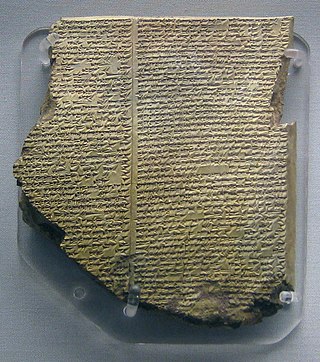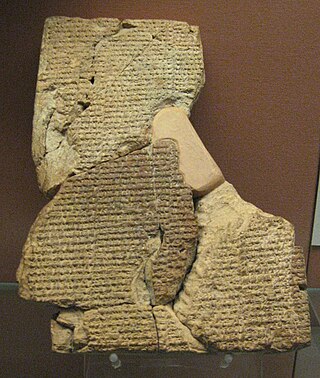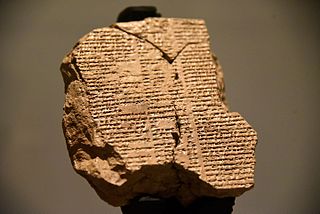
Gilgamesh was a hero in ancient Mesopotamian mythology and the protagonist of the Epic of Gilgamesh, an epic poem written in Akkadian during the late 2nd millennium BC. He was possibly a historical king of the Sumerian city-state of Uruk, who was posthumously deified. His rule probably would have taken place sometime in the beginning of the Early Dynastic Period, c. 2900 – 2350 BC, though he became a major figure in Sumerian legend during the Third Dynasty of Ur.

The Epic of Gilgamesh is an epic poem from ancient Mesopotamia. The literary history of Gilgamesh begins with five Sumerian poems about Gilgamesh, king of Uruk, some of which may date back to the Third Dynasty of Ur. These independent stories were later used as source material for a combined epic in Akkadian. The first surviving version of this combined epic, known as the "Old Babylonian" version, dates back to the 18th century BC and is titled after its incipit, Shūtur eli sharrī. Only a few tablets of it have survived. The later Standard Babylonian version compiled by Sîn-lēqi-unninni dates to somewhere between the 13th to the 10th centuries BC and bears the incipit Sha naqba īmuru. Approximately two-thirds of this longer, twelve-tablet version have been recovered. Some of the best copies were discovered in the library ruins of the 7th-century BC Assyrian king Ashurbanipal.

Shamash was the ancient Mesopotamian sun god, earlier known as Utu. He was believed to see everything that happened in the world every day, and was therefore responsible for justice and protection of travelers. As a divine judge, he could be associated with the underworld. Additionally, he could serve as the god of divination, typically alongside the weather god Adad. While he was universally regarded as one of the primary gods, he was particularly venerated in Sippar and Larsa.The moon god Nanna (Sin) and his wife Ningal were regarded as his parents, while his twin sister was Inanna (Ishtar). Occasionally other goddesses, such as Manzat and Pinikir, could be regarded as his sisters too. The dawn goddess Aya (Sherida) was his wife, and multiple texts describe their daily reunions taking place on a mountain where the sun was believed to set. Among their children were Kittum, the personification of truth, dream deities such as Mamu, as well as the god Ishum. Utu's name could be used to write the names of many foreign solar deities logographically. The connection between him and the Hurrian solar god Shimige is particularly well attested, and the latter could be associated with Aya as well.

Humbaba, originally known as Ḫuwawa in Sumerian, was a figure in Mesopotamian mythology. The origin and meaning of his name are unknown. He was portrayed as an anthropomorphic figure comparable to an ogre or giant. He is best known from Sumerian and Akkadian narratives focused on the hero Gilgamesh, including short compositions belonging to the curriculum of scribal schools, various versions of the Epic of Gilgamesh, and several Hurrian and Hittite adaptations. He is invariably portrayed as the inhabitant or guardian of the cedar forest, to which Gilgamesh ventures with his companion Enkidu. The subsequent encounter leads to the death of Humbaba, which provokes the anger of the gods. Humbaba is also attested in other works of Mesopotamian literature. Multiple depictions of him have also been identified, including combat scenes and apotropaic clay heads.

Enkidu (Sumerian: 𒂗𒆠𒄭EN.KI.DU10) was a legendary figure in ancient Mesopotamian mythology, wartime comrade and friend of Gilgamesh, king of Uruk. Their exploits were composed in Sumerian poems and in the Akkadian Epic of Gilgamesh, written during the 2nd millennium BC. He is the oldest literary representation of the wild man, a recurrent motif in artistic representations in Mesopotamia and in Ancient Near East literature. The apparition of Enkidu as a primitive man seems to be a potential parallel of the Old Babylonian version (1300–1000 BC), in which he was depicted as a servant-warrior in the Sumerian poems.

Ninsun was a Mesopotamian goddess. She is best known as the mother of the hero Gilgamesh and wife of deified legendary king Lugalbanda, and appears in this role in most versions of the Epic of Gilgamesh. She was associated with Uruk, where she lives in this composition, but she was also worshiped in other cities of ancient Mesopotamia, such as Nippur and Ur, and her main cult center was the settlement KI.KALki.
Siduri, or more accurately Šiduri, is a character in the Epic of Gilgamesh. She is described as an alewife. The oldest preserved version of the composition to contain the episode involving her leaves her nameless, and in the later standard edition compiled by Sîn-lēqi-unninni her name only appears in a single line. She is named Naḫmazulel or Naḫmizulen in the preserved fragments of Hurrian and Hittite translations. It has been proposed that her name in the standard edition is derived from an epithet applied to her by the Hurrian translator, šiduri, "young woman." An alternate proposal instead connects it with the Akkadian personal name Šī-dūrī, "she is my protection." In all versions of the myth in which she appears, she offers advice to the hero, but the exact contents of the passage vary. Possible existence of Biblical and Greek reflections of the Šiduri passage is a subject of scholarly debate.
Gilgamesh is a Japanese manga series written and illustrated by Shotaro Ishinomori. It was serialized in the Shōnen Gahōsha magazine Weekly Shōnen King from 1976 to 1978. In 2003, an anime series based on the original story was produced by Ishimori Entertainment and animated by Group TAC and Japan Vistec. Gilgamesh is set in the near future and the plot revolves around characters who can be divided into four groups: The Countess and the Orga-Superior, the Mitleid Corporation, the siblings, and the Gilgamesh. With the development of the plot, the past and motives of the characters and their relationships with one another are exposed.

The elixir of life, also known as elixir of immortality, is a potion that supposedly grants the drinker eternal life and/or eternal youth. This elixir was also said to cure all diseases. Alchemists in various ages and cultures sought the means of formulating the elixir.
Gilgameš is an opera in three acts by Rudolf Brucci. The libretto by Arsenije Arsa Milošević is based on the Mesopotamian Epic of Gilgamesh. It premiered on November 2, 1986 at the Serbian National Theatre in Novi Sad.

Shamhat is a female character who appears in Tablets I and II of the Epic of Gilgamesh and is mentioned in Tablet VII. She is often characterized as a sacred prostitute, though this identification has been contested, and she plays a significant role in bringing the wild man Enkidu into contact with civilization.

The Cedar Forest is the glorious realm of the gods of Mesopotamian mythology. It is guarded by the demigod Humbaba and was once entered by the hero Gilgamesh who dared cut down trees from its virgin stands during his quest for fame. The Cedar Forest is described in Tablets 4–6 of the Epic of Gilgamesh. Earlier descriptions come from the Ur III poem Gilgamesh and Huwawa.

Ut-napishtim is a legendary king of Shuruppak in southern Iraq, who survived the Flood by making a boat.
Epic is a narrative genre characterised by its length, scope, and subject matter. The defining characteristics of the genre are mostly derived from its roots in ancient epics. An epic is not limited to the traditional medium of oral poetry, but has expanded to include modern mediums including film, theater, television shows, novels, and video games.
There are many references to ghosts in ancient Mesopotamian religion – the religions of Sumer, Babylon, Assyria and other early states in Mesopotamia. Traces of these beliefs survive in the later Abrahamic religions that came to dominate the region.
The Epic of Gilgamesh is an oratorio for solo voices, chorus and orchestra by Bohuslav Martinů composed in 1954–1955 near Nice in France, and premiered in 1958 in Basel, Switzerland, with a title and text in German, as Das Gilgamesch-Epos.

In ancient Mesopotamian mythology, the Bull of Heaven is a mythical beast fought by the hero Gilgamesh. The story of the Bull of Heaven is known from two different versions: one recorded in an earlier Sumerian poem and a later episode in the Standard Babylonian Epic of Gilgamesh. In the Sumerian poem, the Bull is sent to attack Gilgamesh by the goddess Inanna for reasons that are unclear.

The Statue of Gilgamesh at the University of Sydney, Camperdown, was created by Assyrian-Australian artist Lewis Batros on commission from the Assyrian community, and unveiled in 2000. The 2.5m statue depicts Gilgamesh, an ancient Sumerian king of the city-state of Uruk whose legendary exploits are told in the Epic of Gilgamesh, an Akkadian epic poem written during the late second millennium BC, based on much earlier material.

Mesopotamian mythology refers to the myths, religious texts, and other literature that comes from the region of ancient Mesopotamia which is a historical region of Western Asia, situated within the Tigris–Euphrates river system that occupies the area of present-day Iraq. In particular the societies of Sumer, Akkad, and Assyria, all of which existed shortly after 3000 BCE and were mostly gone by 400 CE. These works were primarily preserved on stone or clay tablets and were written in cuneiform by scribes. Several lengthy pieces have survived erosion and time, some of which are considered the oldest stories in the world, and have given historians insight into Mesopotamian ideology and cosmology.
Tale of Gudam, also known as the Gudam Epic or Inanna and Gudam, is a Mesopotamian myth known from two Old Babylonian copies from Nippur. It tells the tale of Gudam, an otherwise unknown character, who goes on a rampage in Uruk. The minstrel Lugalgabagal criticizes his behavior, but his remarks only enrage him more. He is finally stopped by a fisherman of Inanna. The goddess herself subsequently decides to spare his life when he starts pleading, and sends him to live in a ditch near Zabalam. Many aspects of the story are a subject of debate in Assyriology, including the nature of Gudam and the identity of the fisherman. Possible connections between the Tale of Gudam and other texts have also been noted. In particular, Gilgamesh and the Bull of Heaven is considered a close parallel, with some authors outright considering the two texts to be variants of one narrative.

















